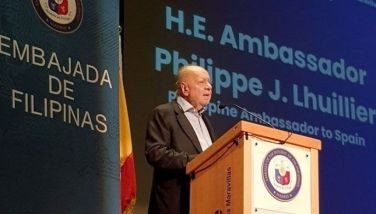Ramon Jacinto: The Pied Piper of Rock
May 19, 2002 | 12:00am
 It’s been a long, strange trip for Ramon Pereyra Jacinto. RJ’s road trip began with a precocious adolescence that painlessly segued into master-of-the-universe yuppiehood. Then came a bully that took it all away, followed by exile and self-discovery. A revolution cleared the way for a triumphant return, while a genius for self-promotion ensured everything he touched turned into gold. Next came the inevitable fall from grace. Today, a more focused RJ is at the peak of his powers, much to the mortification of purists who prefer their rock and roll icons more menacing and tortured, with the craggy facial lines that attest to a lifetime of pharmaceutical experimentation.
It’s been a long, strange trip for Ramon Pereyra Jacinto. RJ’s road trip began with a precocious adolescence that painlessly segued into master-of-the-universe yuppiehood. Then came a bully that took it all away, followed by exile and self-discovery. A revolution cleared the way for a triumphant return, while a genius for self-promotion ensured everything he touched turned into gold. Next came the inevitable fall from grace. Today, a more focused RJ is at the peak of his powers, much to the mortification of purists who prefer their rock and roll icons more menacing and tortured, with the craggy facial lines that attest to a lifetime of pharmaceutical experimentation.
RJ? He’ll gladly leave the angst to the struggling musicians–the self-proclaimed Main Man is too busy having a ball.
By now, the story has become folklore to the legion of RJ fans. At the age of 15, RJ set up RJ Enterprises, which produced and released records of his school band, RJ and The Riots. The entity was to be the first in a long line of eponymous businesses. RJ Enterprises pioneered multi-track recording in the country as the first owner of the Amper 300-3 track machine, positively Jurassic today but cutting edge for a time when mp3’s were just a twinkle in the eyes of the Fraunhofer engineer’s granddaddy.
Two years later at the age of 17, RJ established DZRJ in the backyard of his parents’ New Manila home. There is something quixotic about the image of a teenaged RJ and his classmates spinning Beatles and Beach Boys records, their AM radio station’s weak, static-filled 500-watt signal barely reaching the Ateneo campus where they studied. But RJ’s father–Fernando Jacinto, among the Philippine steel industry’s founders and socially eminent enough to be known as Don Fernando–made it clear from the beginning that the venture would be no rich son’s pasttime.
"My dad made me do a project study–of course, it wasn’t such a great one," smiles RJ. "He endorsed me to a bank and I had to pay the loan back so it was a real project. I borrowed P200,000, which is worth maybe P5 million today.
"We literally had a radio tower in our backyard! I had no overhead because my classmates manned it. I would go to the US around twice a year, buy all these records, and bring boxes of all these LPs–that’s what we would play. We generated a lot of listenership right away because it was an underground thing. But it was hard getting sponsors. It took us maybe two years."
RJ and the Riots could even be seen on TV. In the early ‘60s, Fr. James Reuter, a Jesuit priest, developed a program called Santa Zita and Mary Rose, a weekly television drama where the heroines were housemaids. The weekly episodes were mostly written by Mary Rose Jacinto, RJ’s sister, who also hosted the program. Jacinto Steel covered most of its expenses.
By the mid-sixties, Fr. Reuter was producing seven popular programs weekly, including a show called–you guessed it–RJ and the Riots. High-spirited as it was, the rock-and-roll variety show could never be confused as the forerunner of the Pinoy punk movement (especially because it was produced by a cleric so unrelentingly wholesome, you might say he was the Uncle Bob of television producers).
"We were like the poste, the lead guys there. It also featured the Ateneo Glee Club, dancing and mostly amateurs from different schools–something like the Ed Sullivan Show," RJ reminisces. Unlike in the popular but morally uptight US show, there was no need to censor the gyrations of rogue lead singers by filming them from the waist up. "We didn’t really wiggle like The Stones. Rock ‘n Roll then was still sort of safe and clean."
The radio station was soon running itself and RJ eventually graduated with honors from Ateneo de Manila University (Economics). He also began taking up evening classes in law at the University of Sto. Tomas. By the time he was in his mid-twenties, RJ was Senior VP of his father’s Iligan Steel, with 2,500 employees reporting to him. It appeared the young gun had it all–he was chauffeured in limousines and feted by Ford Motors officials when in Detroit and New York and even his personal secretaries flew first class. To cap it all, he played a mean guitar. Life was good.
On his way back to the country from Europe, where the family had celebrated Don Fernando’s birthday, RJ received miserable news. "It’s good that I stopped over in Tokyo because I received all these telexes from my dad not to go back to the Philippines. I was told there was a ‘political accident’!"
Ferdinand Marcos had declared Martial Law on Sept. 21, 1972 and all Jacinto family assets were forcibly seized and placed under military control, including two of RJ’s radio stations, DZRJ and DZUW. The family’s executives were jailed with no charges.
"For a while I was very bitter," he says. "How could this happen? How can someone just come in and take away your grandfather and father’s lifetime’s work? But I guess there was a Grand Plan in which we had to play a role. Some people lost their lives. Look at people like Sergio Osmeña who ended up in jail.
"I realized from a very early stage that money can come and go. It’s your conviction that matters. It was a lesson for me–I didn’t extend the bitterness too much because it would have destroyed me. All of a sudden, everything was gone. That’s when you realize the real life. I was very philosophical about it."
It was the start of an exile that would last 14 years, 12 of which were spent in the U.S. Using their business connections with Mitsubishi Corporation, the Jacintos set up a ramen fast food chain called Dosanko. He recalls, "I acted as the maitre d’ and my brother worked in the kitchen–we just survived. The news going around here was that we were living in Switzerland and enjoying our yacht. It was completely false but that’s how they justified hanging on to our properties." RJ proudly points out that, for a while, he was traveling around the States with Ninoy Aquino.
While in the US, RJ penned two songs that condensed the paradox of his music. There’s Philippines My Philippines, which he wrote in 15 minutes (it shows). While there’s no doubting the patriotic fervor that veritably drips from the song, there are many eminently sound reasons why it did not usurp Magkaisa as the theme song of EDSA I. It is precisely RJ’s appetite for anthemic songs that alienates music lovers who demand the subtle turn of phrase. In a way, this penchant for the literal also suffuses his covers of rock and roll classics–he can effortlessly sound just like Elvis or McCartney or Santana, and not enough like Ramon Jacinto. Perhaps the trouble is that RJ is so unabashed about his love for music, his earnestness gets in the way.
But there is no denying his gift for melody. In 1977, RJ wrote Muli with help from a Yamaha Portatone drum machine and inspiration from a failed marriage (he is now happily married to his childhood friend, Frannie). He secretly sent the record to the Philippines for airplay. Although DJs in his sequestered radio station could not mention the artist (lest they be castigated by the military management), it became an instant hit.
Muli was utterly irresistible, from the first guitar strains that are exuberantly joined by a jovial entourage of drum and bass to the Filipino/English callback at the end of the song (Sinasabi ko sa ‘yo/You know I keep on telling you). The memorable chorus, framed by a delicate wah-wah, showcased all the virtues of RJ’s rousing musicianship–a no-frills, crystal clear voice and underrated, just-play-the-damn-song guitar work.
Muli was hardly flawless. Lyrics like Kung ang isip mo’y hindi/’di na tayo magmamahalan/Paalam na hanggang muli/Sikat ng araw dito sa lansangan betray RJ’s mild discomfort with the Filipino language (years away from the mother country does tend to dull the native tongue). The song may not possess the painful lyrical voyeurism of the Eraserheads’ Huling El Bimbo or the spellbinding melancholy of Himig Natin by Juan de la Cruz, but it remains, 25 years later, among the catchiest and most singable songs in Pinoy pop history.
In 1986, ten days after the EDSA Revolution–where his own Radyo Bandido played a vital role hosting the calm, guiding voice of June Keithley during those bleak days of swirling rumors–RJ returned to the Philippines. "The first thing I did was kiss the ground, literally, at the airport," he says. The pope-like act would not be the end of RJ’s dramatic flourishes. The Main Man would soon become ubiquitous.
The government returned his radio stations and all the family’s steel mills, except for the largest one–the now government-owned National Steel Corporation, which went to Bobby Ongpin’s Department of Trade and Industry during the Marcos years. What followed was a dizzying series of triumphs and setbacks.
First, there was a radio station to resurrect. In 1986, manning DZRJ eight hours a day for two weeks while awaiting its formal turnover from the military, his sunny voice filled the airwaves with: "Hi, this is Ramon Jacinto. Some of you know me as RJ. Some of you don’t remember me and don’t even know there is a man behind the name RJ. Well, I own this station but I’ve been gone for 14 years. Help me by calling in and suggesting what I should do...." The response was overwhelming–and The Maestro of Retro found his broadcasting niche amid 23 cutthroat FM stations on the dial playing the same Top 40 hits. RJ now runs and operates ten radio stations throughout the country.
He bought a hole-in-the-wall guitar repair shop owned by Rudy Discipulo and turned it into a world-class guitar manufacturer. He flogged his wares on his own cable channel called, naturally, RJ 29, earning the dubious distinction of being among the country’s pioneers in Home TV Shopping. He put up a consumer bank, a finance company, a wireless broadband company, a Radioshack franchise and a shopping mall.
There were also disappointments. He ran and lost in two elections, one in 1992 for Senator under Fidel Ramos’s then ragtag party, the other a more recent failed bid for Congress. He has no regrets. "It was like a travelogue. I learned about the masa, the boondocks of Davao, about how you can buy fish from a Butuan fisherman for P20 yet buy it for P120 here in Manila."
More spectacularly, RJ turned heads after a record-breaking bid for a prime 8,000-square meter PNB lot in Buendia, Makati prior to the real estate nosedive following the Asian currency crisis. Answering allegations of foul play, he says, exasperated, "I never touched any part of the loan. That went back to the 80 percent financing of the mortgage. This is what people don’t understand: RJ borrowed two billion but what they don’t know is that two billion went back to PNB! And they have the land in mortgage plus I gave a downpayment of $40 million, including interest. Now, it’s just a matter of returning the property. We now have a term sheet on the settlement."
Just as spectacular was the success of Bistro RJ, a phenomenally lucrative ‘60s Rock-and-Roll music lounge that became the watering hole of the country’s movers and shakers. After remorselessly negotiating a hard bargain with the struggling owners of the Pasay Road, Makati location, RJ saved even more money by soundproofing the ceiling with egg crates. "I just wanted to play for my classmates and my friends–I didn’t know it would be such a phenomenon! It was the best deal I ever made–I got my money back in two nights! From then on, it was pure profit." The bar lasted just as long as his exile–14 years, a record of sorts.
During EDSA 2, a mysterious band called The Ousters walked up the stage at the EDSA Shrine, their faces concealed by Zorro-like masks. The band quickly launched into a feisty anti-Erap song patterned after Wooly Bully by Sam the Sham and the Pharaohs. As soon as they sang Nagulat ang depensa/Nang lumabas si Clarissa/May dalang ebidensya/Na-shock si Mendoza!…Huling-huli na si Erap ay si Velarde, the crowd erupted, with many screaming, "Si RJ! Si RJ!" It was RJ and the New Riots doing what they do best. The "White Album" sold like hotcakes in street rallies and their mp3s were extremely popular downloads over the Internet.
The scene is being replayed at the EDSA Shangri-La Hotel every Friday night. Whatever they’re paying him is certainly not enough, for the hotel’s normally staid lobby is transformed weekly into a shoulder-to-shoulder tumult of retro passions. The place absolutely rocks. In front of the stage is the baby boomer version of the mosh pit, with scores of fans dancing with the bottomless chirpiness of their teenage years. Holding it all together is the besuited Main Man, for a few a parody of the aging rocker, for the majority a paragon of eternal youth.
"I feed off the energy when people are dancing and in a frenzy," says RJ. "They’re like in heaven. My God, you would have to be very dense not to be able to absorb that energy. Once, during a concert in the States in 1991, while doing the last number my drummer fainted! I was still going."
Rock rolls many ways. It would be a poor bet to wager against Ramon Jacinto playing until he’s a centenarian. Like the Energizer Bunny, his batteries simply refuse to discharge.
BrandSpace Articles
<
>
- Latest
- Trending
Trending
Latest















